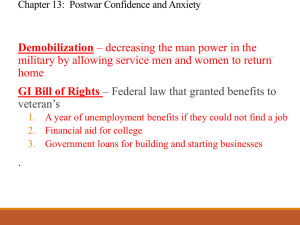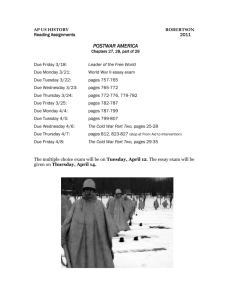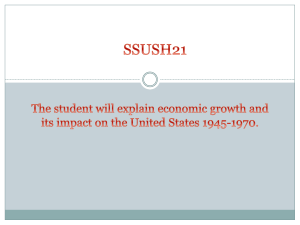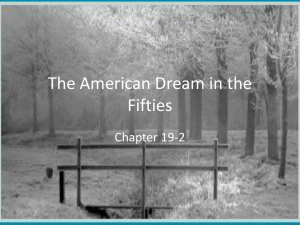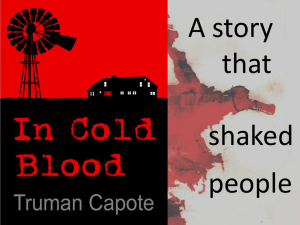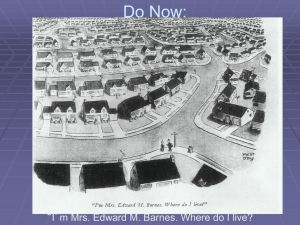Chapter 13: Postwar Confidence and Anxiety
advertisement
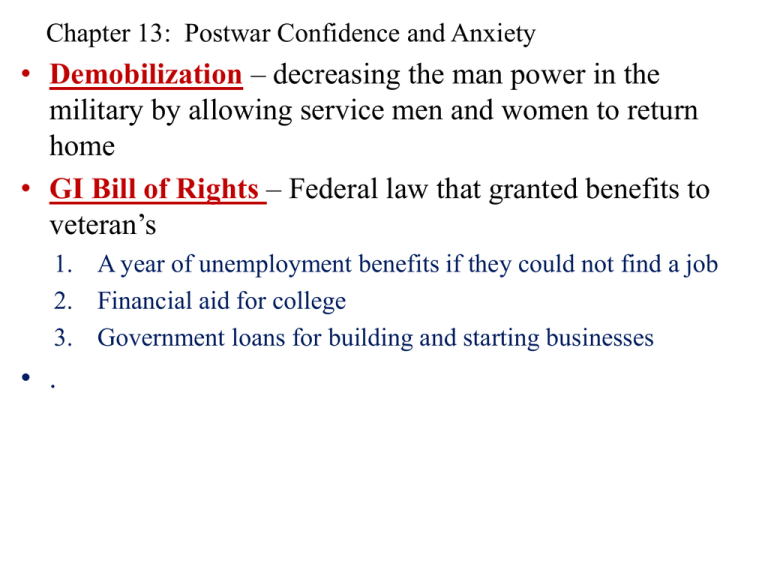
Chapter 13: Postwar Confidence and Anxiety • Demobilization – decreasing the man power in the military by allowing service men and women to return home • GI Bill of Rights – Federal law that granted benefits to veteran’s 1. A year of unemployment benefits if they could not find a job 2. Financial aid for college 3. Government loans for building and starting businesses • . 1A. Baby Boom It seems to me that every other young housewife I see is pregnant. -- British visitor to America, 1958 1957 1 baby born every 7 seconds 1B. Baby Boom Dr. Benjamin Spock and the Anderson Quintuplets Converting War Time Economy • Inflation most painful economic problem after war • U.S. untouched by war’s devastation – U.S. produce 50% of world’s output • Technology improves productivity – Use of computers began in business • Increased military spending leads to new technologies – Development of plastics and light metal alloys – Marshall Plan increased demand for American goods The Taft-Hartley Act • Republicans take control of both houses of Congress in 1946 and seek to return to a conservative government: – – – – – Lower taxes Reduced government regulation Support for business Anti-Union – reduce the power of unions to aid business End price controls passed during the war • Taft, a conservative Republican Senator sponsored act – Authorized President- 80 day cooling off period for strikes in essential industries – Banned shops closed to non-union members Truman Vetoes but is overridden Truman and Civil Rights • Supports the trend in post war America against intolerance- Lesson of discrimination of the Nazis- rings loud and clear- Nuremberg Trials began, the truth of Nazi racism comes out • War was fought for freedom- freedom should be available at home • Some former soldiers don’t like racism in USA • American society is developing conditions for change emerge Incremental Civil Rights for African Americans • 1946 Morgan v. Virginia- segregation in public interstate travel was unconstitutional • 1950- Shelley v. Kraemer- restrictive covenants in housing- not selling property to members of certain groups violated the Constitution Civil Rights • Truman desegregated the Military and Federal Civil Service • Big step in the early struggle for an end to discrimination Election 1948 • Southern Democrats leave national party in response to Truman's support for Civil Rights • Dixicrats • Strom Thurmond- South Carolina Senator, runs for president • Dewey runs for the Republicans • Truman appeared to lose- but appeals directly to the people citing the “Do nothing Republican Congress” and Wins the Election Fair Deal • Liberal programs of Truman similar to New Deal – National health insurance • Limited and refused by Republican Congress 1946 Eisenhower Charts Middle Path • Eisenhower popular choice for president in 1952 – both parties wanted him!! • First elected post he ever held was president • Charted middle course – Agreed government was too big, but did not repeal New Deal programs – Federal spending increased during his presidency The Car Culture Automania • Cheap, plentiful gas, easy credit, advertising increase car sales • No public transit in suburbs; cars necessary Car Culture Takes Over • Depended on cars to get to work • Cars necessary to grocery shop or go to new suburban shopping malls • Fast food restaurants and drive-in movies capitalize on car • Towns near highways prosper; those near older, smaller roads decline NEXT continued The Car Culture Mobility Takes Its Toll • Cars create social, environmental problems— e.g. accidents, pollution • Upper-, middle-class whites leave cities; jobs, businesses follow • Economic gulf widens between suburban and urban - also widens gap between middle class and the poor NEXT Chapter 13: Postwar Confidence and Anxiety • Interstate Highway Act 1. $$$ to build 41,000 miles of highway consisting of multilane expressways that would connect the nation’s major cities 2. Biggest public works expenditure in history 3. Modeled after the German Autobahn that Hitler built 4. Ike’s plan for rapid mobilization in times of international crisis. 5. In 1990, became known as the Dwight D. Eisenhower System of Interstate and Defense Highways Chapter 13: Postwar Confidence and Anxiety • Sunbelt – Name given to southern and western states during the migration of the U.S population from eastern and northern cities • Houston, TX - Benefited from boom in petrochemical and aerospace business • Migration had a heavy impact on the shift of representative power in Congress • California and Texas are now players in the Electoral College game • Factors in move – – – – Climate Large number of jobs (especially defense industries) Air conditioning Influx of Latino populations Chapter 13: Postwar Confidence and Anxiety The Organization and the Organization Man Employment in the U.S. • By 1956, majority of Americans not in blue-collar (industrial) jobs • More in higher-paying, white-collar (office, professional) positions • Many in services, like sales, advertising, insurance, communications (service sector) Conglomerates • Conglomerates—corporation that owns smaller, unrelated companies • Diversify to protect from downturns in individual industries NEXT The Organization and the Organization Man Franchises • Franchise—company offers similar products, services in many places - also the right to use company name and system • Fast-food restaurants among first, most successful franchises Social Conformity • Many employees with well-paid, secure jobs lose individuality • Personality tests see if job candidates fit in company culture • Companies reward teamwork, loyalty, encourage conformity NEXT Chapter 13: Postwar Confidence and Anxiety • Multinational Corporation - Companies that produced and sold their goods and services all over the world and established branches abroad. • General Motors, General Electric, International Business Machines, Coca-Cola • Consumerism – large-scale buying, most of it on credit • Union Gains – 1955 AFL and CIO combine to form AFL-CIO • Educational Opportunities – Number of young people attending college increase – Government funds education (science and math) – California Master Plan Consumerism Unbound New Products • 60% of Americans in middle class; twice as many as before WW II • Consumerism (buying material goods) equated with success • Numerous new products appear on market in response to demand Planned Obsolescence • Planned obsolescence—making products that get outdated, wear out - makes consumers buy or want to buy new ones NEXT continued Consumerism Unbound Buy Now, Pay Later • Credit purchases, credit cards, installments extend payment period • Private debt grows; consumers confident of future prosperity The Advertising Age • Most people have satisfied basic needs; ads encourage extra spending • Psychological appeals in ads lure consumers to particular products • Ads appear in all media; television emerges as powerful new tool Consumerism Well-Defined Gender Roles The ideal modern woman married, cooked and cared for her family, and kept herself busy by joining the local PTA and leading a troop of Campfire Girls. She entertained guests in her family’s suburban house and worked out on the trampoline to keep her size 12 figure. -- Life magazine, 1956 Marilyn Monroe The ideal 1950s man was the provider, protector, and the boss of the house. -- Life magazine, 1955 1956 William H. Whyte, Jr. The Organization Man A a middle-class, white suburban male is the ideal. Religious Revival Today in the U. S., the Christian faith is back in the center of things. -- Time magazine, 1954 Church membership: 1940 64,000,000 1960 114,000,000 Television Preachers: 1. Catholic Bishop Fulton J. Sheen “Life is Worth Living” 2. Methodist Minister Norman Vincent Peale The Power of Positive Thinking 3. Reverend Billy Graham ecumenical message; warned against the evils of Communism. Religious Revival Hollywood: apex of the biblical epics. The Robe 1953 The Ten Commandments 1956 Ben Hur 1959 It’s un-American to be un-religious! -- The Christian Century, 1954 The Suburban Lifestyle Advances in Medicine and Childcare • New drugs fight, prevent childhood diseases • Dr. Jonas Salk develops vaccine for poliomyelitis • Pediatrician Dr. Benjamin Spock writes popular guide for parents • Baby boom impacts economy, educational system NEXT Popular Culture New Era of the Mass Media The Rise of Television • Mass media—means of communication that reach large audiences • TV first widely available 1948; in almost 90% of homes in 1960 • Federal Communications Commission (FCC) regulates communications • By 1956, FCC allows 500 stations to broadcast • Programs: comedies, news, dramas, variety shows, children’s shows • Lifestyle changes: TV Guide is popular magazine; TV dinners NEXT New Era of the Mass Media Stereotypes and Gunslingers • Women, minorities on TV are stereotypes; few blacks, Latinos • Westerns glorify historical frontier conflicts • Raise concerns about effect of violence on children Radio and Movies • Television cuts into radio, movie markets • Radio turns to local news, weather, music, community affairs • Movies capitalize on size, color, sound advantages; try gimmicks NEXT Television 1946 7,000 TV sets in the U. S. 1950 50,000,000 TV sets in the U. S. Television is a vast wasteland. Newton Minnow, Chairman of the Federal Communications Commission, 1961 Mass Audience TV celebrated traditional American values. Truth, Justice, and the American way! Television – The Western Davy Crockett King of the Wild Frontier Sheriff Matt Dillon, Gunsmoke The Lone Ranger (and his faithful sidekick, Tonto): Who is that masked man?? Television - Family Shows Glossy view of mostly middle-class suburban life. But... I Love Lucy Social Winners?... The Honeymooners AND… Loosers? African Americans and Rock ‘n’ Roll Rock ‘n’ Roll • Black musicians add electric instruments to blues—rhythm and blues • Rock ‘n’ roll—mix of rhythm and blues, country, pop • Has heavy rhythm, simple melodies, lyrics about teenage concerns • Music appeals to newly affluent teens who can buy records • Many adults concerned music will lead to delinquency, immorality NEXT Teen Culture In the 1950s the word “teenager” entered the American language. By 1956 13 mil. teens with $7 bil. to spend a year. 1951 “race music” “ROCK ‘N ROLL” Elvis Presley “The King” Teen Culture Behavioral Rules of the 1950s: U Obey Authority. U Control Your Emotions. U Don’t Make Waves Fit in with the Group. A Subculture Emerges The Beat Movement • Beat movement—writers, artists express social, literary nonconformity • Poets, writers use free, open form; read works aloud in coffeehouses • Beatnik attitudes, way of life attract media attention, students NEXT The “Beat” Generation: f Jack Kerouac On The Road f Allen Ginsberg poem, “Howl” f Neal Cassady f William S. Burroughs “Beatnik” “Clean” Teen The Other America The Urban Poor White Flight • 1962, 25% of Americans below poverty level • Post WW II–1960, 5 million blacks go from rural South to urban North • White flight results in loss of businesses, tax payers to cities • Cities can no longer afford to maintain or improve: - schools, public transportation, police and fire departments • The Other America by Michael Harrington – documents changes in cities Continued . . . NEXT continued The Urban Poor The Inner Cities • Poverty grows rapidly in decaying inner cities • Poor economic conditions lead to illness and terrible conditions Urban Renewal • Urban renewal—replace rundown buildings with new low-income housing • Housing and Urban Development Dept. created to improve conditions • Not enough housing built for displaced people NEXT Rural Poor •Plight of rural poor just as bad •Included Mississippi delta sharecroppers, miners in Appalachia and farmers in remote areas •Corporations and large farmers dominated farm production, forcing small farmers out of business •Many left to the urban areas, some remained behind hoping for better economic times Poverty Leads to Activism Mexicans Seek Employment • Many Southwest Mexicans become U.S. citizens after Mexican War • 1942–47, Mexican braceros, hired hands, allowed into U.S. to work • After war, many remain illegally; many others enter to look for work The Longoria Incident • Undertaker refuses funeral services to Felix Longoria, WW II veteran • Outraged Mexican-American veterans organize G.I. Forum • Unity League of CA registers voters, promotes responsive candidates Continued . . . NEXT continued Poverty Leads to Activism Native Americans Continue their Struggle • During Depression, U.S. policy of Native American autonomy • National Congress of American Indians: civil rights, maintain customs • U.S. stops family allotments, wages; outsiders take tribal lands The Termination Policy • Termination policy cuts economic support, gives land to individuals • Bureau of Indian Affairs helps resettlement in cities • Termination policy is a failure; abandoned in 1963 NEXT

